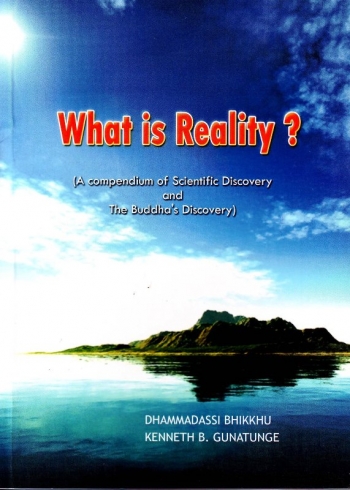When enlightenment happened in the 17th century Europe, giving precedence to reason over scripture, the Church was still resolute in its truth-claims. Science had to fight long and hard with its solid discoveries and evidences that have been fascinating human minds for centuries. Science has influenced so much in every aspect of our life that it has now become a fashion to add the word ‘science’ to any academic discipline and thought. However Buddhism in unique in that it has retained the same linguistic and spiritual vigour as it did in its beginning. It has maintained its own vocabularies, reasons, and propositions and practices for the realization of truth. Buddhism has a well defined goal and a systematic path to achieve the goal. It never opposed scientific discoveries as long as they were in line with ethical values. Therefore it is not surprising that a Buddhist monk and a scholar would compile a compendium of scientific and Buddhist discoveries titled as “What is Reality?”
The book has two parts independent of each other. The first part is on scientific discovery (consisted of 12 chapters) and the second part is on the Buddha’s discovery (consisted of 13 chapters). In the first part, some important scientists and scientific theories and explanations about the universe, the gravitation, relativity, quantum mechanics, etc. are introduced. Unlike a typical science book, facts are presented here in a very simple and lucid language. The authors have tried their best to avoid many of scientific jargons and mathematical formulas for easy comprehension of the readers. From the very beginning there is an attempt to present the facts in a narrative style. The first chapter, for example, begins with a fictitious conversation between an ordinary person and a scientist who talk about space, time and distance from two different perspectives. For the ordinary person everything has a real existence, but, for the scientist, their existence is conditionally relative and they do not have an absolute existence. The ordinary person is confused by these explanations. The objective of the book ‘What is Reality?’ is to solve these puzzles of an ordinary person, firstly by providing scientific explanations and secondly by providing Buddhist explanations about the human beings, the world, and their place and activities in the universe.
The second part introduces the Buddha’s discovery. At a glance of the chapters in this book, readers may notice that the scientific exploration begins from an attempt to understand the external world and universe, while, the Buddhist exploration begins from within the individual. The scientific approach is understood as the macroscopic whereas the Buddhist approach is defined as microscopic. This is the most fundamental difference of the two approaches. After a brief introduction about the Buddha’s renunciation the authors go on to explain the Buddha’s discoveries after enlightenment. In that historic night of his enlightenment, the Buddha cleared all the mental defilements and thoroughly examined the constituents of an individual – the mental aspects and physical aspects – and how they interacted with each other. This exploration resulted in the supreme purification and perfection of wisdom.
The significant feature of the book is its non-judgmental approach. It strictly refrains from comparing or contrasting between Science and Buddhism to prove superiority or inferiority of one over the other. The reader is exposed to two distinct approaches to reality; one is free to come to his/her own conclusions.
Finally it is appropriate to mention that Albert Einstein has been quoted for his famous statement: “If there is any religion that would cope with modern science, it is Buddhism”. Whatever Einstein may mean, the book “What is Reality?” can be taken as an illustration of his statement.















